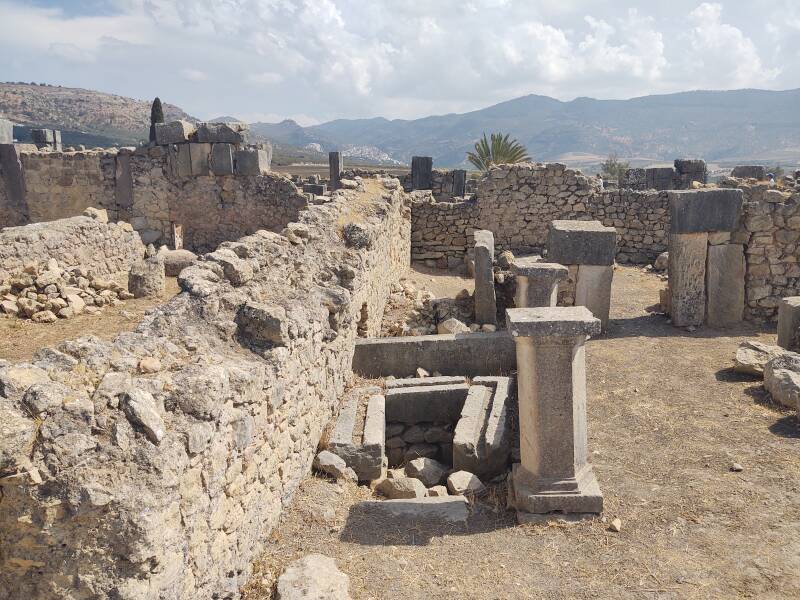
Meknès
Meknès — Toilets of Morocco
VisitingMeknès
Meknès
was the first of three imperial cities
I visited in Morocco,
places where the Sultan lived.
Fez and Marrakech were the other two.
An imperial city has a large
kasbah,
a specially fortified section of the old city.
Given the cruelty of the Sultans,
especially Moulay Isma'il who ruled from Meknès
for 55 years from 1672 to his death in 1727,
the kasbah walls often protected the Sultan from his subjects
at least as much as from his external enemies.
The immense sand-colored walls with elaborate gateways
seemed to me to be out of Central Asia,
or maybe Robert E. Howard's tales of the
Hyborian Age.
However, Meknès is over 5 degrees west of London!
Riad Ma Bohème
Findingmy lodging
I arrived in Meknès on a train from Tangier. I took a petit taxi from the ville nouvelle, the European-style "new town" the French built during the Protectorate, to Place el-Hedim on the edge of the medina, the walled old city filled with narrow passageways. From there I walked to my guesthouse. This was a little more challenging than in Tangier where I stayed on a small but prominent square. In Meknès I entered the medina through a gateway into a narrow lane and continued in for sixty meters, turned onto another lane for another hundred meters, and then turned off onto a derb. That's a narrower dead-end passage that is built over in places, making it like a darkened hallway.
Guesthouses at Booking.comI was looking for Riad Ma Bohème, where I had reserved a room. A riad or ryad is a sturdy structure built around a central courtyard. Several, like this one, now operate as guesthouses.
I had a great room, it was a very nice place to stay. And, the room only cost about US$ 20 per night. Here is my private bathroom:
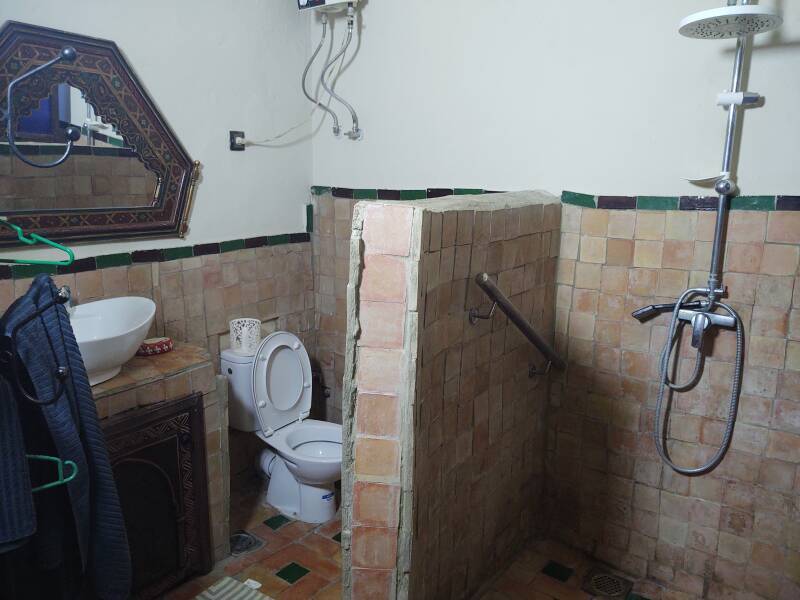
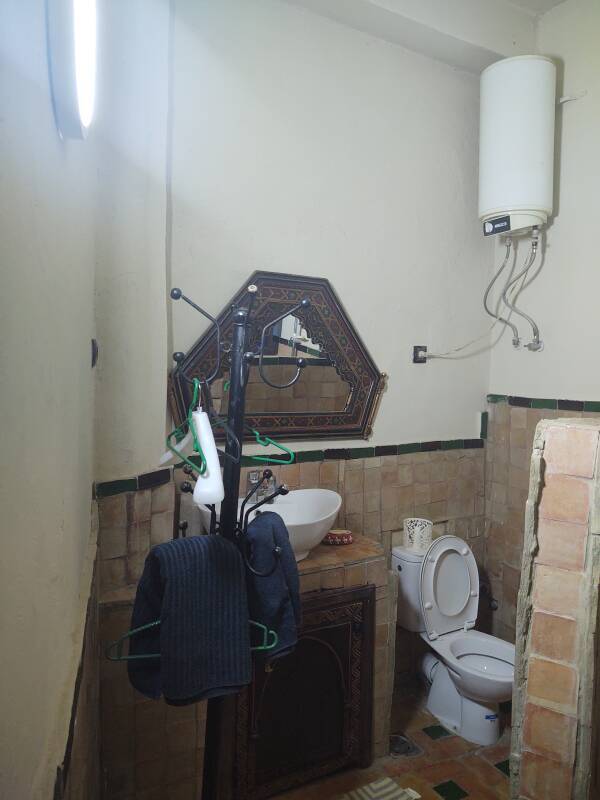
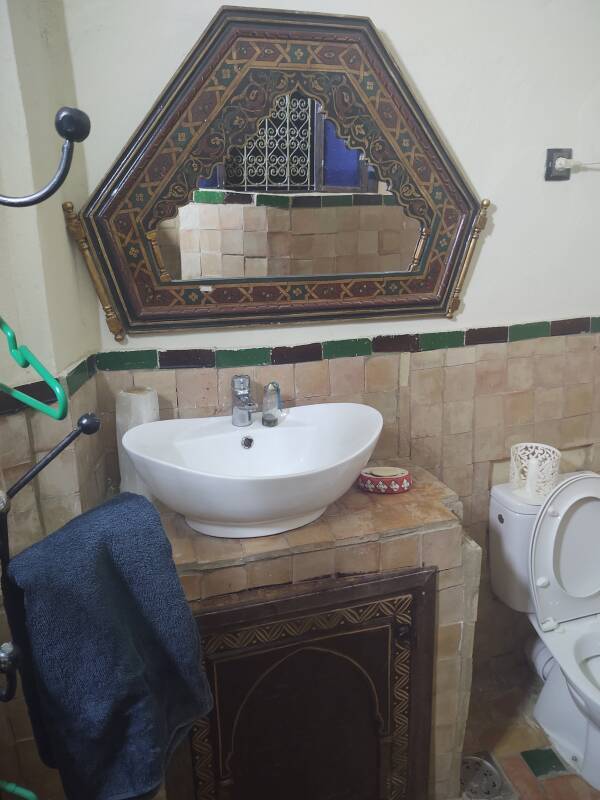
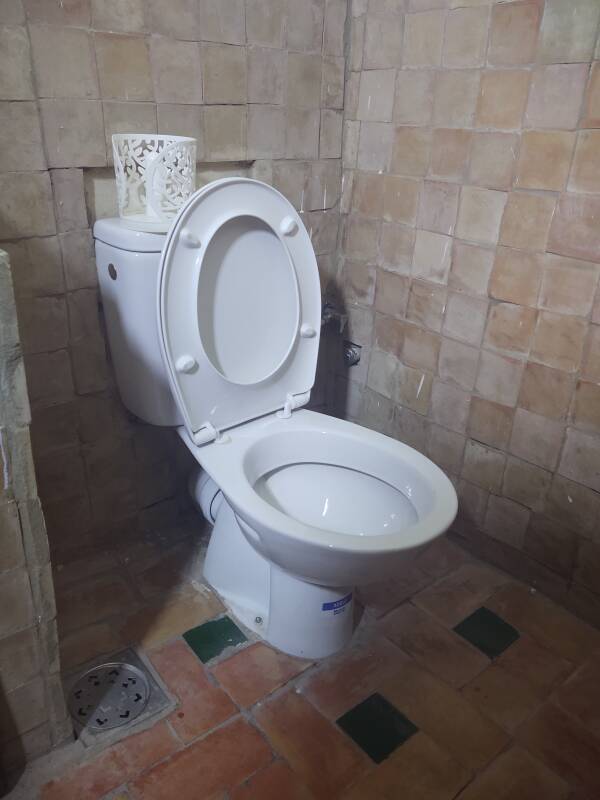
The window next to the shower looked out from this upper floor into the central courtyard of the riad. Like many of the places where I stayed in Morocco, the guesthouse was built like a fortress with very few exterior openings. Windows in guest rooms open into hallways or courtyards.
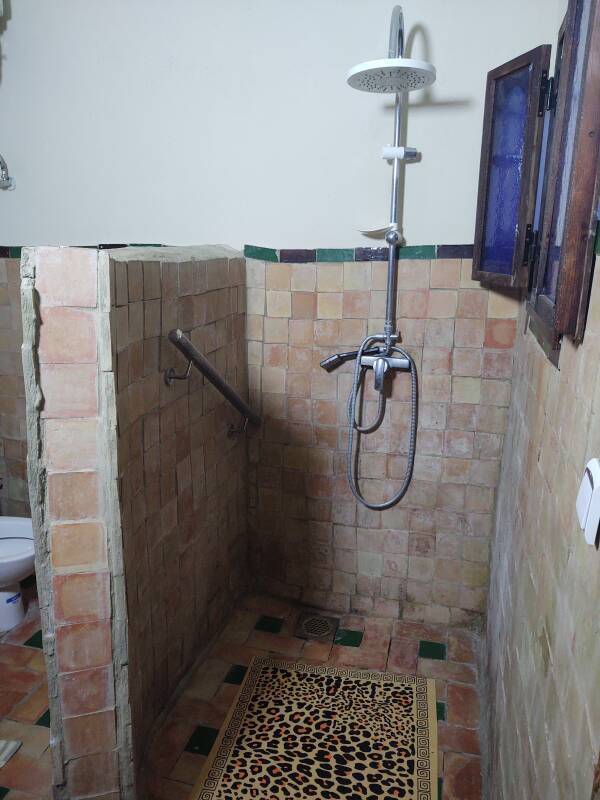
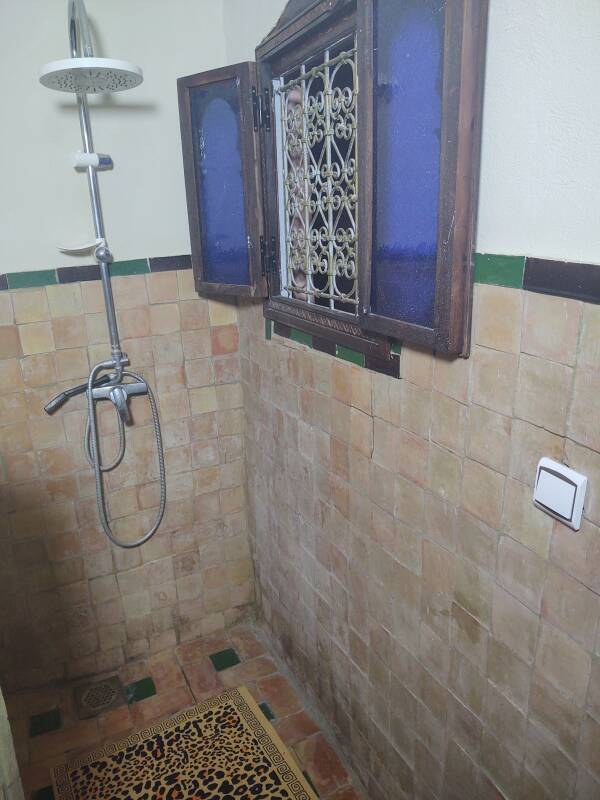
Imperial Plumbing
Visitingthe Kasbah
in Meknès
Any principal city in Morocco has a Dar el-Makhzen or the House of the Makhzen, a Moroccan royal residence.
The Royal Palace of Meknes is also known as Al Mhancha. It is within the large kasbah built by Moulay Isma'il in 1672. There are fountains by the gateways in the outer perimeter wall, like this one across from the large public square called Place el-Hedim.

A year after the end of the French Protectorate in 1956, the ruler of Morocco changed his title from Sultan to King to emphasize the unity of the country. Morocco is populated by Berbers and Arabs, but "Sultan" gave the impression of Arab rule.
The current King, Muhammad VI, took the throne in 1999. He likes golf. The palace complex in Meknès is large enough to contain a rather exclusive 9-hole golf course. Avenue Bab Marrah runs through the kasbah for a kilometer in a straight line along the north side of the current palace. It's good to be the king.
As you walk along that avenue between two high, mostly blank, fortified walls, you pass a gateway and this fountain.
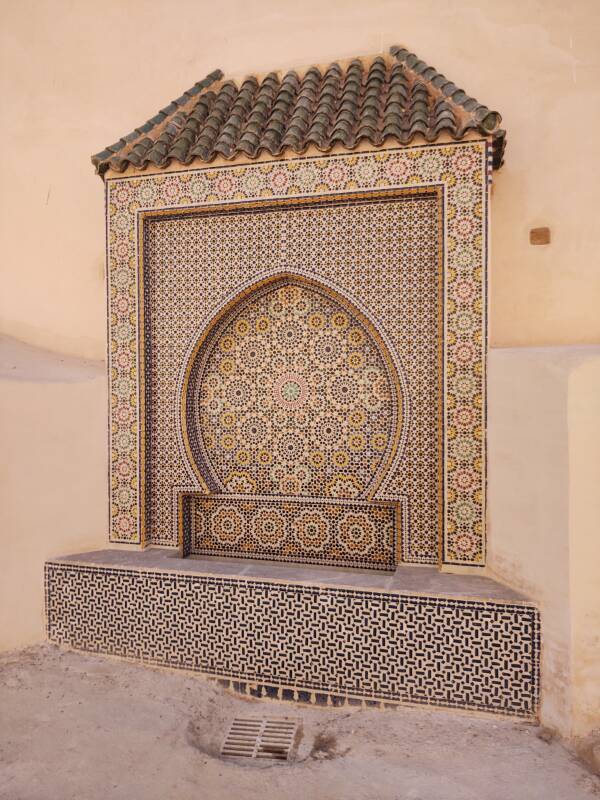
There is a cluster of large infrastructure systems to the south-southeast of the Cité Impériale. These included two large-scale water handling systems.
Heri es-Souani or Sahrij Souani was an immense granary next to the water systems. It was over 180×100 meters in size. It's often mistakenly called the "royal stables", but it was a grain storage warehouse stockpiling supplies to withstand a long siege.
Dar al-Ma or the House of Water, also called the "House of the Ten Norias", was on the northeast side of the Heri es-Souani silos.
The Bassin Souani, also known as the Agdal Basin, was an artificial lake holding over 57 million liters of water.
The palace complex had highly developed infrastructure. Its water supply was especially sophisticated, at least a century ahead of the infrastructure found in European palaces. It distributed water to buildings throughout the kasbah via canals and underground terracotta pipes.
The Dar al-Ma or the House of Water is also known as the House of the Ten Norias, named for the mechanical system that drew water from a deep well. It is on the northwest side of the Heri es-Souani silos, at the southeast end of the Bassin Souani.
It is a massive structure with a large central chamber surrounded by fifteen domed chambers. Each of those held a noria, a mechanical system with a series of buckets on a chain loop which was operated by a horse-driven wheel. The chain loop carried the buckets down into the water table and then drew them up filled with water. The buckets emptied their water into the supply for the terracotta plumbing network.
1: If you're from the U.S., one cubic foot is 957.506494 fluid ounces or 59.844156 pints.
The Bassin Souani or the Agdal Basin extends to the northwest from the Dar al-Ma. It forms a water reservoir about 149 by 319 meters, about 1.2 meters deep on average. Doing the simple math, that's 149×319×1.2 or 57037.2 cubic meters. One cubic meter is 1,000 liters, so the reservoir holds just over 57 million liters.[1] The reservoir had its own two-meter-thick defensive wall, of which just a short section remains. The royal city had walls within walls within walls, defense with many layers.
Approaching the Dar al-Ma and Bassin Souani you pass a set of public toilets.
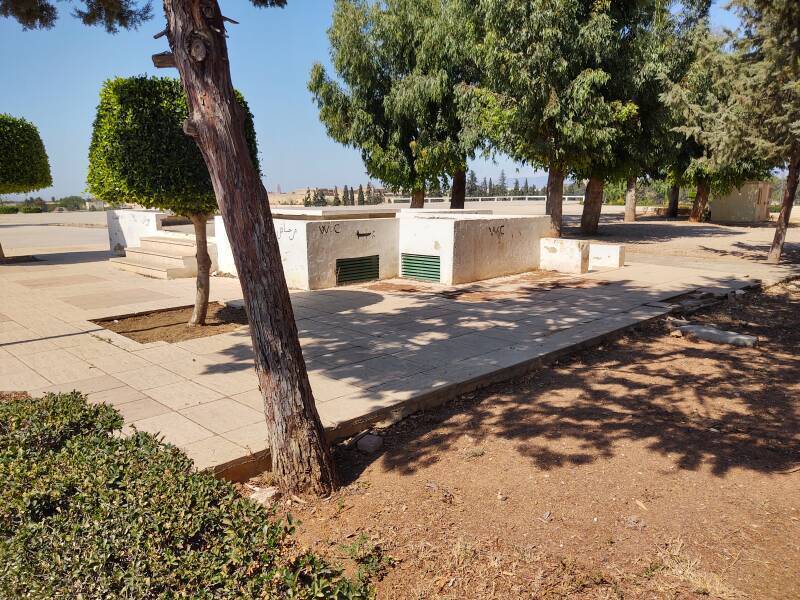
I visited in late September 2022, when many things were closed due to the many renovations and repairs being done during what we hoped was the late-stage pandemic. So, no blue border for having used this one.
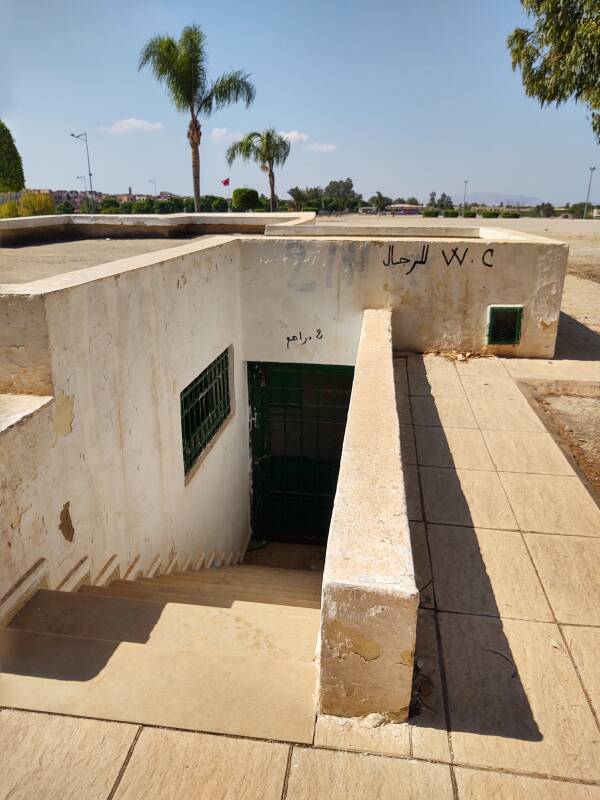
Vehicular and pedestrian gateways allow passage through the nearby interior fortification wall.
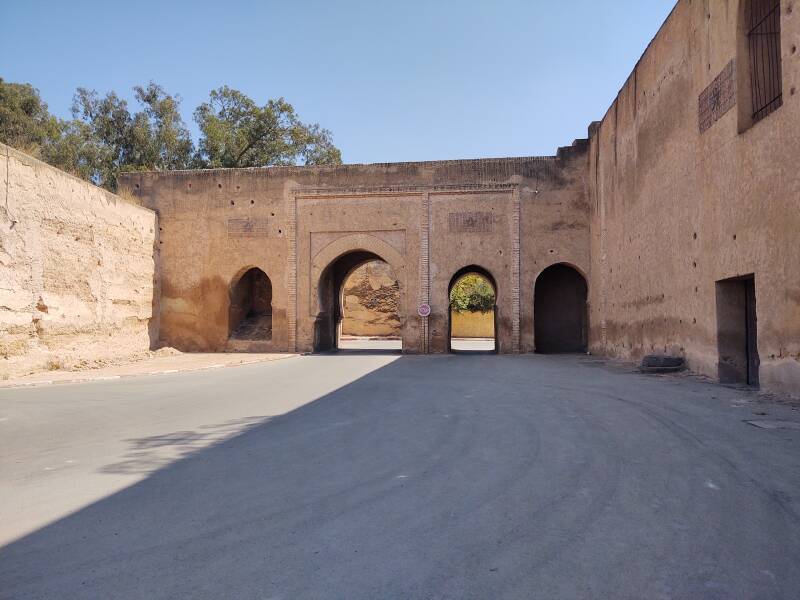
The large Heri es-Souani and connected Dar al-Ma have a small entrance.
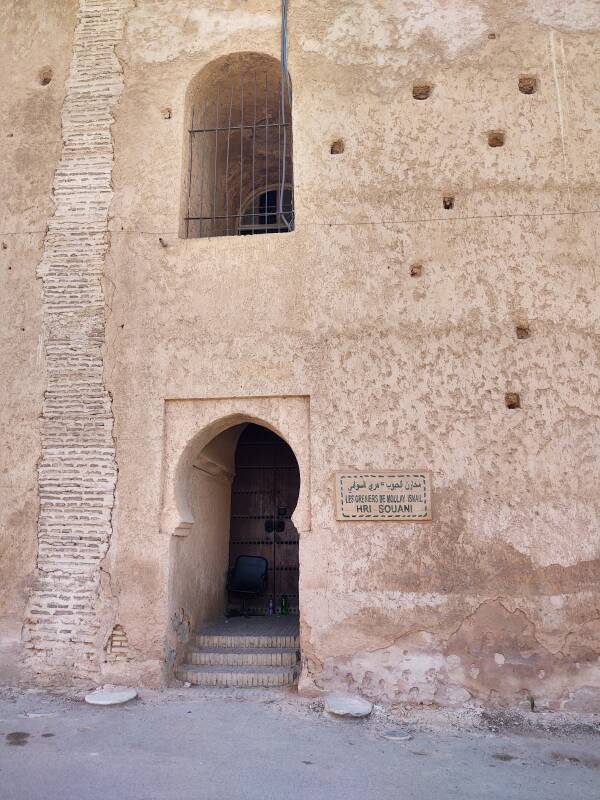
The Heri es-Souani and the Dar al-Ma or the House of the Ten Norias stand above the end of Bassin Souani. This is the relatively short end, 149 meters wide.
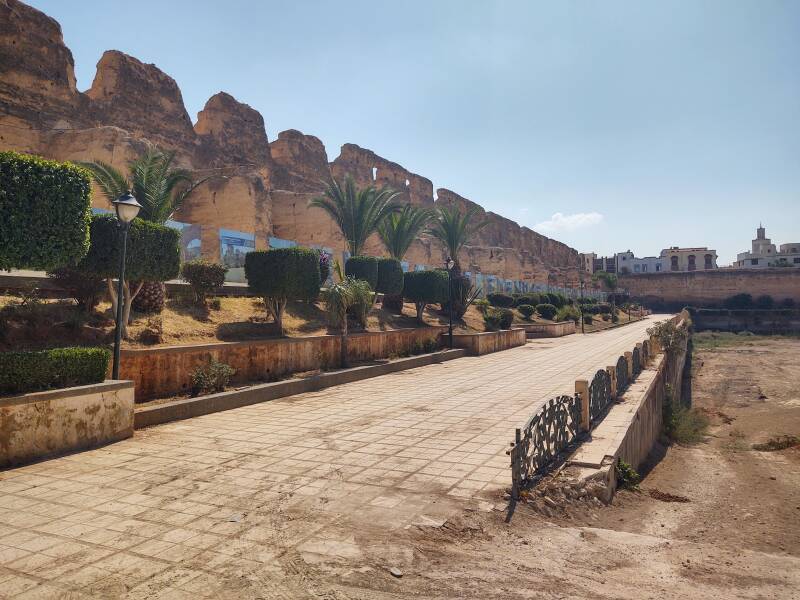
Upper-story homes in the neighborhood have a view of the reservoir. It was drained during my visit, usually it's full of water.
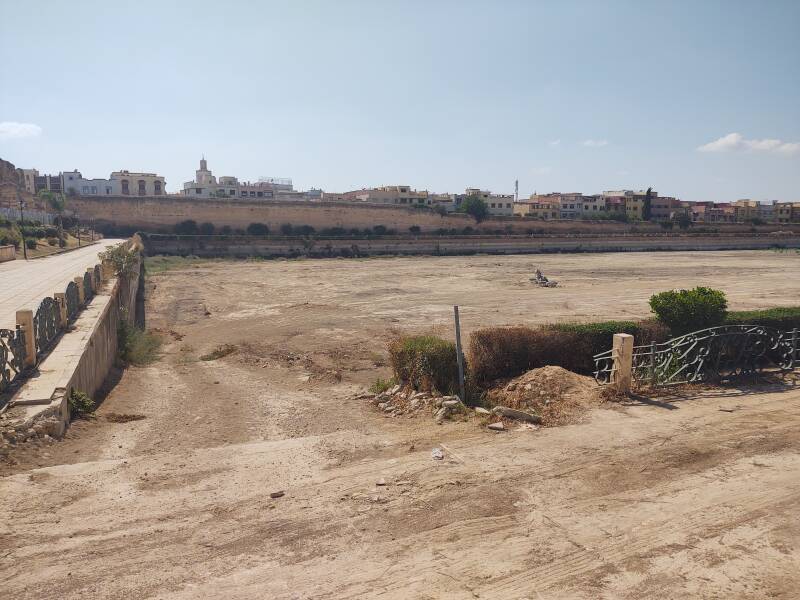
The far end is almost 320 meters away.
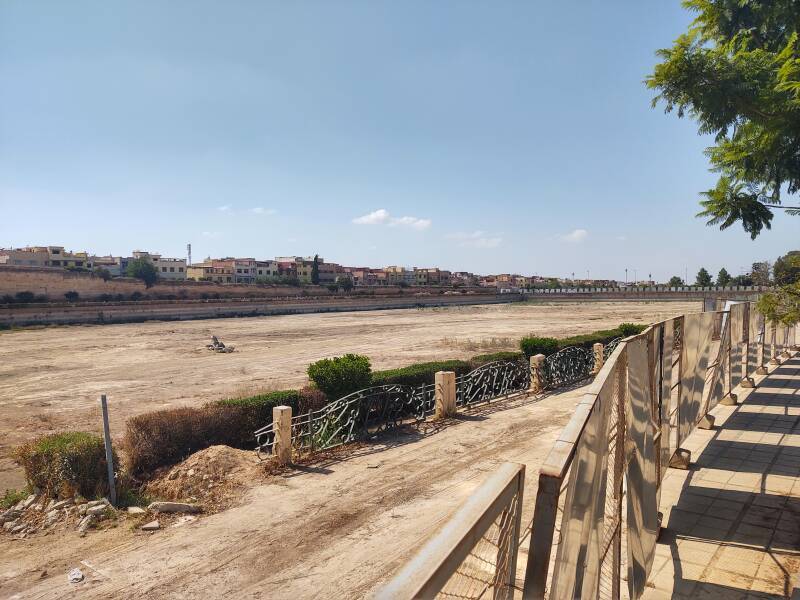
In the Medina
VisitingDar Jama'i
Dar Jama'i on Place el-Hedim is a late 19th century palace built in 1882 by Mokhtar ben Arbi el Jama'i. He and his brother served as Grand Vizier under Sultan Moulay Hassan (ruled 1873–1894).
When that Sultan died in 1894, his younger son Moulay Abdelaziz was installed on the throne with the assistance of Ba Ahmed, who happened to be a rival of the Jama'i family. And so the Jama'i family fell from power, and many of their assets, including the Dar Jama'i palace, were confiscated. The Dar Jama'i palace was given to the Glaoui family.
Then the French colonial rule came along in 1912. The French colonial rulers seized control of Dar Jama'i. They converted it into a military hospital, and then into a military court, and then, in 1920, a Musée d'art indigène, meaning the rather unexciting "indigenous costumes, jewelery, and personal items" theme that it maintained until the very early 2020s.
But now, wow, it's very different. The museum is now an immersive experience in Moroccan architecture and music.
The overall design follows traditional Moroccan architecture. Carved and painted wood, carved stucco, and multicolored zillij mosaic tilework cover the surfaces.
Each room has Moroccan music playing, and there is a wide range of choices. Many of the rooms also have video panels showing the artists performing what you are hearing.
And, there are elaborate fountains like this one off an internal courtyard.
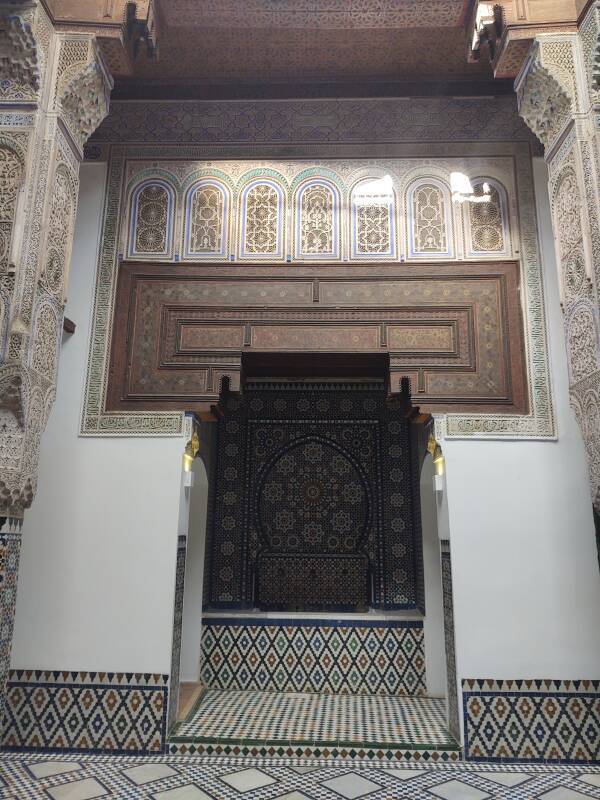
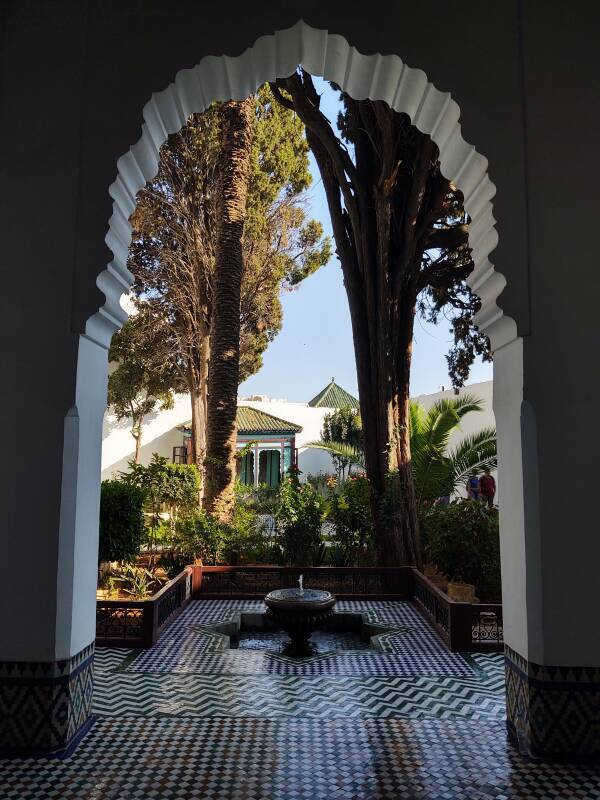
Plus, there's a tile-decorated fountain in the walled garden within the museum grounds.
The Dar Jama'i is on the edge of the walled medina, at the north end of Place el-Hedim. Of course there are fountains all through the narrow passages of the medina, like this one near the main mosque.
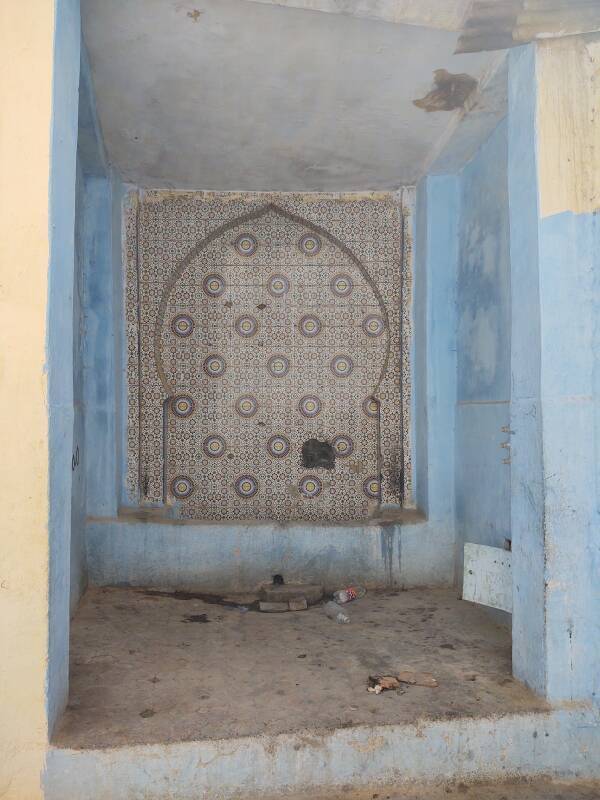
Volubilis
Berber-Romanplumbing at
Volubilis
Volubilis is a Berber-Roman city a short distance north of Meknès. See the dedicated page for many more pictures and details of Volubilis.
Volubilis is an easy day trip from Meknès. First take a petit taxi to the place where the grand taxis collect passengers going to the town of Moulay Idris. That's visible in the distance beyond this poorly restored latrine in the House of Dionysus. Once you're at the grand taxi "station" in Meknès, make sure they understand you want to ride in a taxi collectif, a seat in a shared car going to Moulay Idris. Expect to pay about 7 Dirham for the petit taxi then 11 Dirham for the grand taxi. Then you will have a walk of about 5 kilometers to reach Volubilis.
Non-plumbingsights at
Volubilis
The House of Orpheus is one of the highlights of Volubilis. It's named for a large mosaic floor in a triclinum room, where guests could recline on benches around three sides of the room while eating and drinking, conversing, and gazing upon the mosaic and the large water basin in the adjacent room.
Of course you will want to see its latrine, which had room for many of the owner's guests to visit together. Bench seats along two sides had a flowing water channel underneath. In the foreground is the water tank for cleaning the tersorium, also called the xylospongium, the sponge on a stick used for cleaning yourself in Greek and Roman latrines.
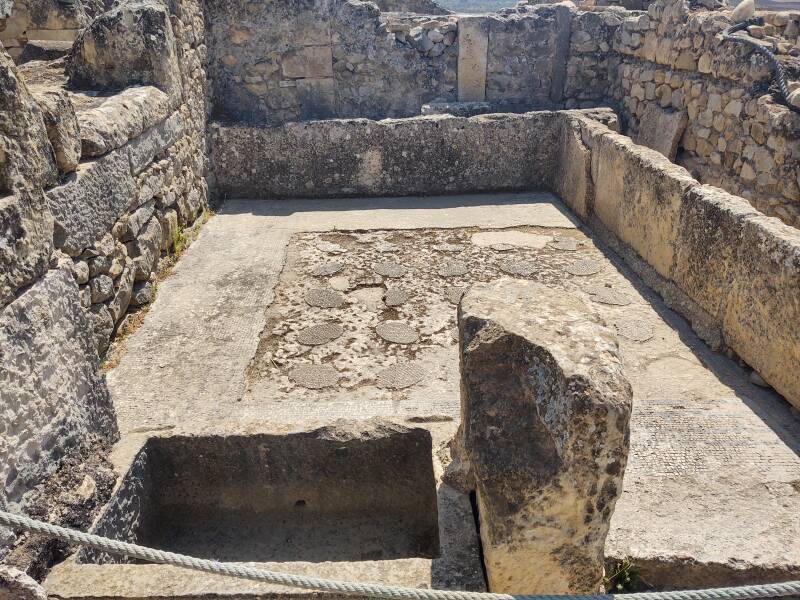
Here is the Orpheus mosaic in the triclinum adjacent to the water basin.
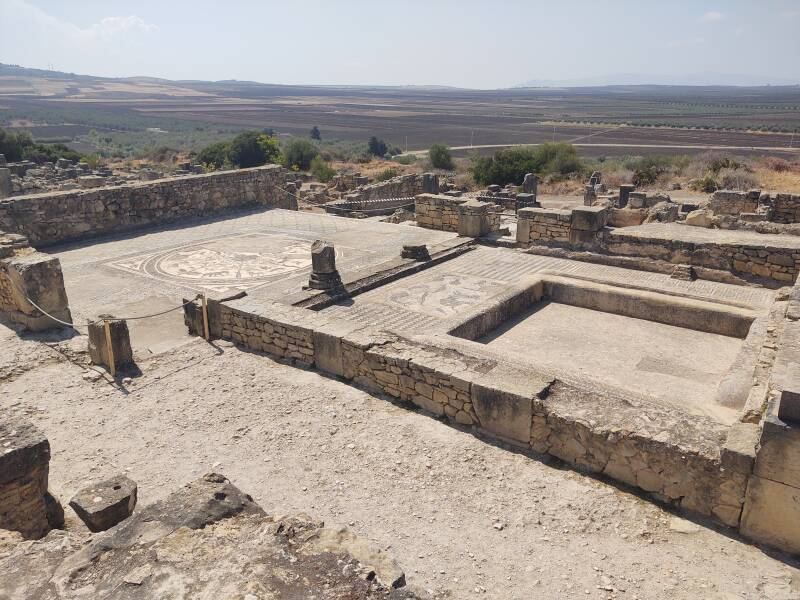
The House of Orpheus had a large private bath despite being just across the street from the civic baths. Well, of course, if you can afford a palatial home with Orpheus mosaic, triclinum, and multi-person latrine, you won't want to routinely bathe with the proletariat.
Brick arches support mosaic-decorated floors over hot water.
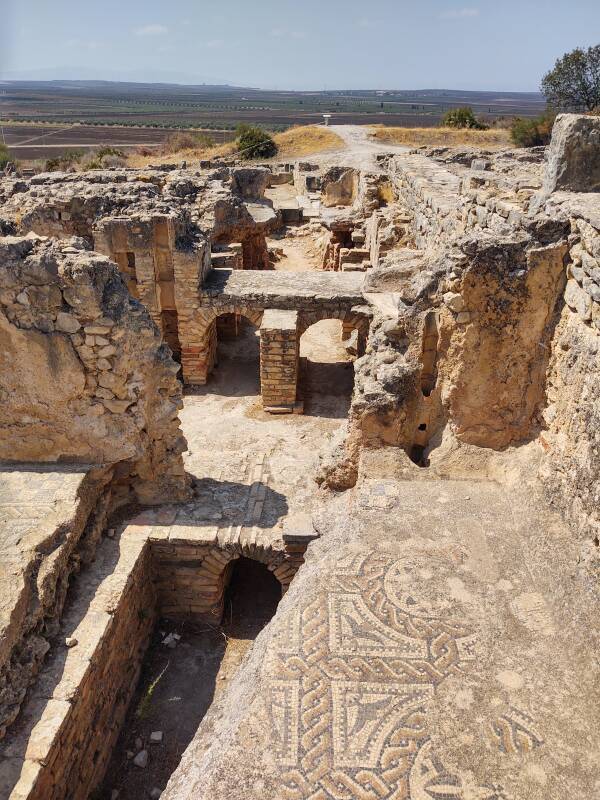
There's much more to see at Volubilis. See the plumbing-specific page or my non-plumbing depiction.
If you're following the pages in the order I visited places during my trip, the next stop is the city of Fez. Or, feel free to jump around:
